|
Recommended Reading
- In partnership with Amazon.com we've compiled a
list of books that we think will improve your skills as a webmaster. These books
cover both beginning and advanced topics in website design, html, unix, cgi programming,
perl, java and javascript. We use many of them every day for reference.
Check out the list below. If you see something you like just click on it and you'll
be able to buy it through Amazon.
Topics:
Website Design
Creating Killer Web Sites presents the web
sites we wish we had created. It explains the key concepts in site structure and
organization and how to use HTML to get the look you want. Some of the sites featured
in this book are just beautiful.
HTML
After you've used HTML authoring tools for a while
you're going to want to learn how to tweak your code a little. These titles will
teach you all you want to know about writing your own HTML. They should be on your
bookshelf.
UNIX
No matter what Microsoft might say, Unix is the
operating system of the internet. Sooner or later you're going to want to telnet
into your website and manually write a cgi program, create a sub-directory or edit
a file. These titles will teach you how to do that and more.
CGI Programming
Great CGI programs are available for free all over
the internet. These titles will teach how to these programs work and how to create
your own. Now you can have web pages that interact with the user. Create counters,
guest books, forms that store data and more.
PERL
Perl is the programming language of the web. Sure
there are plenty of C and C++ programs but most cgi's and web related applications
are written in Perl. Check these titles to find out what Perl can do for you.
Javascript
Javascript programs are embedded into your web pages
and executed by the user's browser. Sounds a little strange but it uses less overhead
and is much faster than interacting over the internet with cgi's. And you'd be amazed
at what Javascript programs can do beyond just rollover buttons. These titles do
a pretty good job of explaining javascript.
JAVA
Everyone's heard of Java but you probably wonder
what you can do with it. We've preloaded the applets from Instant Java on
our servers and here's the book that explains the applets. The other titles show
how you can write your own applets.
Website Design:
Creating Killer Web Sites, Second Edition
by David Siegel
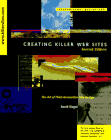 David Siegel's classic guide to good taste in Web design
has been completely overhauled in this second edition. Every chapter has been reworked,
repurposed, and rewritten with over 100 new pages and 150 new illustrations, new
information on 4.0 browser design, and a comprehensive guide to Style Sheet implementations
for both Netscape Navigator and Internet Explorer. Those who enjoyed Creating
Killer Web Sites the first time around will doubtlessly benefit from this new
edition, which is meant as a continuation of the first book rather than a simple
update. At the same time, anyone who has never read the first edition will be able
to pick up this new edition without having missed a beat. Siegel's accompanying Web
site (www.killersites.com) contains supplemental information as well as chapters
from the first edition that didn't make the 2.0 cut. David Siegel's classic guide to good taste in Web design
has been completely overhauled in this second edition. Every chapter has been reworked,
repurposed, and rewritten with over 100 new pages and 150 new illustrations, new
information on 4.0 browser design, and a comprehensive guide to Style Sheet implementations
for both Netscape Navigator and Internet Explorer. Those who enjoyed Creating
Killer Web Sites the first time around will doubtlessly benefit from this new
edition, which is meant as a continuation of the first book rather than a simple
update. At the same time, anyone who has never read the first edition will be able
to pick up this new edition without having missed a beat. Siegel's accompanying Web
site (www.killersites.com) contains supplemental information as well as chapters
from the first edition that didn't make the 2.0 cut.
More of a style guide than an HTML guide, Creating Killer Web Sites is concerned
with the building of Third-Generation sites, Web sites that are conceived by design
and not by technological ability. Siegel and his helpers at Studio Verso overview
a wide variety of topics, including a history of browsers, how to use specific HTML
tags, how to select software tools, and advice on pure aesthetic design. Like the
first edition, the second edition of the book contains an attractive design, a graphic
on every page, and screen shots of successful Web pages that will set any designer's
wheels in motion.
Paperback - 305 pages 2nd edition (October
1997)
Hayden Books; ISBN: 1568304331 ; Dimensions (in inches): 0.73 x 10.03 x 8.02
HTML:
HTML 4 for the World Wide Web: Visual
QuickStart Guide
by Elizabeth Castro
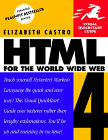 Ask any burgeoning Web-page author what they want in an HTML
guide, and the list would go something like this: concise, informative, plenty of
examples, a little bit of fun without being too cute. Elizabeth Castro's HTML
for the World Wide Web is that dream guide to learning this Web language. Ask any burgeoning Web-page author what they want in an HTML
guide, and the list would go something like this: concise, informative, plenty of
examples, a little bit of fun without being too cute. Elizabeth Castro's HTML
for the World Wide Web is that dream guide to learning this Web language.
Unlike other books that lumber along feeding the reader arcane details, Castro's
book keeps to the basics. You'll still learn everything you need to create a great
site (where to start off, how to nest tables, how to add in video), but you won't
feel overwhelmed by the process. The book is clearly referenced and, in typically
concise Peachpit Press style, full of deceptively simple bullet lists of things to
do. On the other side of the split page are screen shots, illustrations, or other
examples to highlight the steps the reader needs to take to create desired effects.
The book concludes with a listing of special symbols, a color chart, and a well-devised
index of all the goodies contained in this slim--but comprehensive--book.
Paperback - 336 pages 3rd edition
Peachpit Pr; ISBN: 0201696967 ; Dimensions (in inches): 0.82 x 7.02 x 9.12
Html : The Definitive Guide
by Chuck Musciano, Bill Kennedy, Mike Loukides
(Editor)
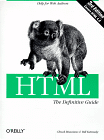 HTML: The Definitive Guide is aimed at beginners as well
as those who have more practice in Web-page creation. The authors assume at least
a basic knowledge of computers, including how to use a word processor or text editor
and how to deal with files. They teach you that learning HTML is like learning any
other language and that reading a book of rules can only take you so far. Readers
begin writing what may be their first Web page just two pages into the book's second
chapter. From there on, they provide a wide range of HTML coding to allow readers
to learn from good examples. The book includes a handy "cheat sheet" of
HTML codes for quick reference. Chock full of examples, sample code, and practical
hands-on advice, this title helps readers to create truly effective Web pages and
master advanced features. Learn how to insert images and other multimedia elements,
create useful links and searchable documents, use Netscape extensions, design forms,
and more. HTML: The Definitive Guide is aimed at beginners as well
as those who have more practice in Web-page creation. The authors assume at least
a basic knowledge of computers, including how to use a word processor or text editor
and how to deal with files. They teach you that learning HTML is like learning any
other language and that reading a book of rules can only take you so far. Readers
begin writing what may be their first Web page just two pages into the book's second
chapter. From there on, they provide a wide range of HTML coding to allow readers
to learn from good examples. The book includes a handy "cheat sheet" of
HTML codes for quick reference. Chock full of examples, sample code, and practical
hands-on advice, this title helps readers to create truly effective Web pages and
master advanced features. Learn how to insert images and other multimedia elements,
create useful links and searchable documents, use Netscape extensions, design forms,
and more.
Paperback - 608 pages 3rd edition (September
1998)
O'Reilly & Associates; ISBN: 1565924924 ; Dimensions (in inches): 1.21 x 9.20
x 7.15
Unix:
UNIX® For Dummies®
by John R. Levine, Margaret Levine Young
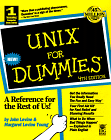
The title of this book invites comment. "Some things weren't meant for dummies
and Unix is one of them," you might say. Wrong! Levine and Young take advantage
of the Dummies format's strength with command-line operating systems. They flatten
the learning curve and have even the greenest beginner doing useful work with Unix
in mere hours. You'll find conceptual explanations of files, directories, permissions,
and redirection. Command explanations take a hybrid form; they mix "type this
verbatim" statements with tables showing switches and parameters. Much of Unix
for Dummies is task-oriented. You'll find a whole chapter on printing, for example,
that covers the commands you'll need to know to format and print a document on the
right printer. Other chapters cover file searches, software installation, and X Windows
navigation. The book also provides cursory coverage of four text editors--ED, vi,
Emacs, and pico--but you learn little more than how to enter and save text in each.
Levine and Young include an eminently useful "DOS-to-Unix Rosetta Stone"
that immediately tells you, for example, that the approximate Unix equivalent of
DOS's copy is cp. DOS experts who are new transplants to a Unix environment will
appreciate this translation guide. The authors wrap up with a wealth of basic troubleshooting
information and a command reference.
Paperback - 408 pages 4th Edition
edition (September 9, 1998)
IDG Books Worldwide; ISBN: 0764504193 ; Dimensions (in inches): 0.99 x 9.17 x 7.38
UNIX Power Tools
by Jerry D. Peek, Tim O'Reilly, Mike Loukides

Unix Power Tools, with its accompanying
CD-ROM, contains thousands of tips, scripts, and techniques that make using Unix
easier, more effective, and even fun. It details tricky yet powerful commands such
as find, xargs, tar, and grep and shares expertise from O'Reilly's Nutshell handbooks,
Usenet, and the authors. The authors supply descriptions and solutions of real-world
problems and give you the ability to analyze and solve them creatively. Designed
for both beginning Unix users and programmers, this 1,000-page tome is designed for
browsing rather than reading cover to cover.
Paperback - 1120 pages 2nd Bk&Cd
edition (October 1997)
O'Reilly & Associates; ISBN: 1565922603 ; Dimensions (in inches): 2.12 x 9.19
x 7.05
CGI Programming:
Instant Web Scripts with CGI Perl
by Selena Sol, Gunther Birznieks (Contributor)

A book/CD-ROM providing professionally written scripts that can be used instantly
on Web pages or customized. Chapters explain how each script is set up and how they
were programed, with sections on installing and using scripts, CGI libraries, databases,
HTML, CGI- based graphics and animation, and miscellaneous applications. The CD-
ROM contains scripts, Perl libraries, and custom libraries. For intermediate-level
CGI developers with knowledge of HTML and the CGI/Perl environment. This book gives
Internet programmers useful, professionally-written scripts to use on their Web pages
and for customizing individual needs. It includes scripts for e-mail and searching
HTML directories, a "Fortune Cookie" generator, a message board system,
and a CGI-based database, as well as an HTML Guestbook and electronic classified
ads page. The CD-ROM contains two well known libraries for Perl 4 and 5, cgi-lib.pl
and cgi.pm, and custom libraries created by the authors.
Paperback (November 1996)
IDG Books Worldwide; ISBN: 1558514902 ; Dimensions (in inches): 1.98 x 9.21 x 7.12
Cgi Programming With Perl
by Shishir Gundavavum
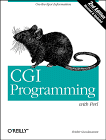
An excellent book for expert programmers, CGI Programming with Perl doesn't
waste time with miscellaneous or frivolous topics, but instead focuses on the workings
of the CGI specification down to the tiniest detail. Author Shishir Gundavaram begins
by explaining what CGI does--material that's probably familiar to most people reading
this book. Fortunately, he promptly moves on to a complete explanation of each of
the CGI methods and environment variables. The author also pays attention to every
language you could conceivably want to use with CGI, especially ever-popular Perl.
But CGI is simple, and there isn't enough to it to merit an alphabetical reference
of more than a chapter in length. So, CGI Programming on the World Wide Web takes
on the task of explaining CGI applications--some unusual ones as well as the usual
suspects. In addition to teaching guest book and quiz applications (you may be better
off with a book that puts its code on a CD-ROM), Gundavaram explains how to port
e-mail and Usenet news to the Web with CGI and details a pretty cool Concentration
game. Just for kicks, he makes the game look good in a text-only browser--a real
technical feat that's kind of fun to read about.
Paperback - 450 pages 2 Ed edition
(October 1999)
O'Reilly & Associates; ISBN: 1565924193
Perl:
Programming Perl (2nd Edition)
by Larry Wall, Tom Christiansen, Randal L. Schwartz, Stephen Potter
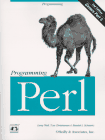 The second edition of the Camel Book is more than 600 pages
long and full of excellent instruction and sound advice. Topics include all the good
stuff from the first edition plus Perl 5 features such as nested data structures
(ever made a hash of arrays of hashes?), modules, and objects. From "Howdy World"
to making your own modules, this book has it all. The second edition of the Camel Book is more than 600 pages
long and full of excellent instruction and sound advice. Topics include all the good
stuff from the first edition plus Perl 5 features such as nested data structures
(ever made a hash of arrays of hashes?), modules, and objects. From "Howdy World"
to making your own modules, this book has it all.
This heavily revised second edition of Programming Perl contains a full explanation
of Perl version 5.002 features. It's the authoritative guide to Perl -- the scripting
utility now established as the World Wide Web programming tool of choice. The book
is coauthored by Larry Wall, the creator of Perl.
Paperback - 645 pages 2nd edition (October
1996)
O'Reilly & Associates; ISBN: 1565921496 ; Dimensions (in inches): 2.74 x 9.20
x 7.08
Teach Yourself Perl 5 in 21 Days
by David Till
 A great book for beginning programmers who want to learn
Perl. Filled with concrete examples and, yes, by using this book you will be able
to write good Perl code on your own in 21days. But no perlson is an island, and there
is no single book that covers Perl completely, so we recommend that you also get
Programming Perl, which is better at providing the language specifications,
and, in fact, was written by the author of Perl. A great book for beginning programmers who want to learn
Perl. Filled with concrete examples and, yes, by using this book you will be able
to write good Perl code on your own in 21days. But no perlson is an island, and there
is no single book that covers Perl completely, so we recommend that you also get
Programming Perl, which is better at providing the language specifications,
and, in fact, was written by the author of Perl.
Paperback - 870 pages 2nd Bk&Cd
edition (July 1996)
Sams; ISBN: 0672308940 ; Dimensions (in inches): 2.01 x 9.13 x 7.39
-
Javascript:
Javascript Bible, 3rd Edition
by Danny Goodman, Brendan Eich
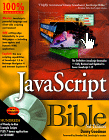 Danny Goodman has repeatedly proven himself an excellent
teacher of programming languages, and this latest edition of JavaScript Bible reinforces
his reputation. If you're familiar with HTML and want to endow your pages with the
kind of animation and interactivity that JavaScript can provide, this book is the
best one you can buy. Danny Goodman has repeatedly proven himself an excellent
teacher of programming languages, and this latest edition of JavaScript Bible reinforces
his reputation. If you're familiar with HTML and want to endow your pages with the
kind of animation and interactivity that JavaScript can provide, this book is the
best one you can buy.
Goodman covers the JavaScript 1.2 language comprehensively, and focuses on developing
documents that fully exploit the capabilities of Netscape Navigator 4.0x. The author
begins with the fundamentals of the language--variables, loops, data structures,
functions, and the like. Then, he proceeds to systematically explore the more difficult
characteristics of the language, including its limited object-orientation features
and the extensions that apply to Dynamic HTML (DHTML). Server-side coverage is sparse,
but that technology isn't nearly as widely used as client-side JavaScript.
JavaScript Bible contains both a tutorial and a reference, so it's useful to advanced
JavaScript programmers as well as to beginners. Plus, the illustrative examples included
in these pages--and on the accompanying CD-ROM--are generally useful. You'll find
image-rollover routines, client-side database lookups, a DHTML puzzle, and many more
programs that you'll be able to quickly adapt to your own projects.
Paperback - 1015 pages 3rd Bk&cdr
edition (March 1998)
IDG Books Worldwide; ISBN: 0764531883 ; Dimensions (in inches): 1.94 x 9.27 x 7.40
Javascript : The Definitive Guide
by David Flanagan
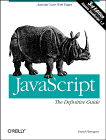
In typical O'Reilly & Associates fashion, this book documents every nuance of
the JavaScript 1.1 language specification. It may appear dry on the surface (many
pages have the spare style of UNIX online documentation), but this is the book you'll
pull off your shelf when you want to know which method returns the primitive value
of an object. Flanagan's book comes out ahead of its competitors in a few other areas,
too. JavaScript features a useful discussion of the limited JavaScript support found
in Microsoft Internet Explorer and provides excellent documentation of LiveConnect,
the software that allows JavaScript to communicate with Java applets. It also offers
a taste of what's in store for the just-released JavaScript 1.2.
The third edition of this definitive reference covers the latest version of JavaScript
-- JavaScript 1.2 -- as supported by Netscape Navigator 4.0. It can be used to help
users create dynamic, interactive, Web-based applications that are powered by JavaScript.
Paperback - 776 pages 3rd edition (June
1998)
O'Reilly & Associates; ISBN: 1565923928 ; Dimensions (in inches): 1.45 x 9.21
x 7.03
Java:
Instant Java (Sun Micrsystems Press
Java Series)
by John A. Pew, Stephen G. Pew
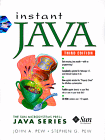
If you're not a programmer, but you've done some HTML and are eager to move on to
bigger and better things, this may be the Java book for you. The book provides a
variety of applets and shows you how to customize them and plug them into existing
Web pages. Jazz up your Web page with audio, animation, ticker tapes, and more! Other
books focus on the theory and technical details of Java, but this one lets you use
text, images and sound on your Web pages immediately. Covers release 1.1.
New edition of a resource for Web authors who are looking to use Java on their Web
sites. Features 140-plus applets with multi- dimensional effects, multi-line and
paragraph capabilities, active time and date facilities, the "Data File"
feature which brings real- time text updates to running applets, and the "Property
Sheet" customizer. The CD-ROM includes all the applets covered in the book and
the latest Netscape browser.
Paperback - 400 pages 3rd Bk&cdr
edition (January 1999)
Prentice Hall Computer Books; ISBN: 0130105333 ; Dimensions (in inches): 0.86 x 6.97
x 9.22
Sams Teach Yourself Java 1.2 in
21 Days (Teach Yourself...)
by Rogers Cadenhead, Laura Lemay
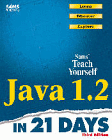
Sams Teach Yourself Java in 21 Days continues to be the most popular, best-selling
Java tutorial on the market. It has been acclaimed for its clear and personable writing,
for its extensive use of examples, and for its logical and complete organization.
The third edition of the book will maintain and improve upon all these qualities
while updating the material to cover the latest developments in the Java language
such as using Java Foundation Classes, Java 2D Classes, and JavaBeans.
Provides step-by-step lessons for the most popular network-oriented, cross-platform
programming language. A thoroughly revised, updated, and improved edition of the
market's leading Java tutorial. Includes new coverage of Java Foundation Classes,
Java 2D Classes, JavaBeans, and the new security model.
Paperback - 680 pages 3rd edition
Sams; ISBN: 1575213907 ; Dimensions (in inches): 1.53 x 7.31 x 9.03
Just Java 2 (Java Series)
by Peter van der Linden
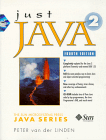
Just Java 2 should be on your desktop. It's one of a select group of introductory
Java books that honestly earns its cover price. Shying away from complicated aspects
of the language that are seldom used in most practical situations, Peter van der
Linden focuses his considerable teaching skills upon the parts of the language you
really need to understand in order to be a good Java programmer. He covers basic
structure and syntax very well, and gives similarly excellent attention to object
orientation and the means by which Java implements it. Applets, Beans, input/output
streams, basic graphics, Swing, and security all get superb coverage.
In short, this book explains everything you really need to know in order to write
useful Java programs. With sharp text and very good example programs, the author
shows you how to get things done. In the process, van der Linden--a funny guy--pauses
often to show you how to make an origami water-bomber or comment upon software error
messages like "runt packet."
The CD-ROM that comes with this book deserves much praise, as well. Packed with honestly
useful tools and all of the author's examples, it employs a fine HTML-based interface
that other books ought to imitate.
Paperback - 777 pages 4th Bk&cdr
edition (January 1999)
Prentice Hall; ISBN: 0130105341 ; Dimensions (in inches): 1.44 x 7.00 x 9.18

Back to Support Index
|